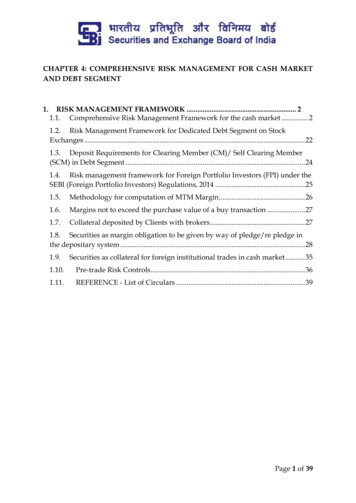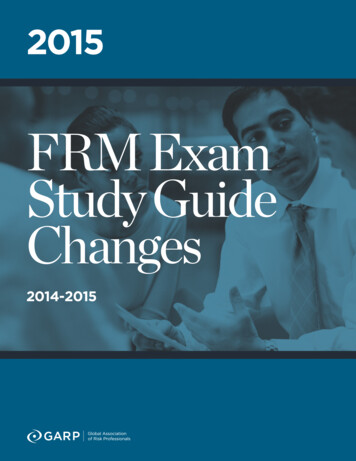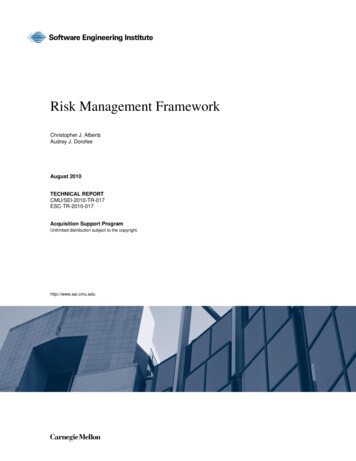
Transcription
CHAPTER 4: COMPREHENSIVE RISK MANAGEMENT FOR CASH MARKETAND DEBT SEGMENT1.RISK MANAGEMENT FRAMEWORK . 21.1. Comprehensive Risk Management Framework for the cash market . 21.2. Risk Management Framework for Dedicated Debt Segment on StockExchanges . 221.3. Deposit Requirements for Clearing Member (CM)/ Self Clearing Member(SCM) in Debt Segment . 241.4. Risk management framework for Foreign Portfolio Investors (FPI) under theSEBI (Foreign Portfolio Investors) Regulations, 2014 . 251.5.Methodology for computation of MTM Margin . 261.6.Margins not to exceed the purchase value of a buy transaction . 271.7.Collateral deposited by Clients with brokers . 271.8. Securities as margin obligation to be given by way of pledge/re pledge inthe depositary system . 281.9.Securities as collateral for foreign institutional trades in cash market . 351.10.Pre-trade Risk Controls . 361.11.REFERENCE - List of Circulars . 39Page 1 of 39
1. RISK MANAGEMENT FRAMEWORK11.1.1.1.1.Comprehensive Risk Management Framework for the cash marketOverviewThe core of the risk management system is the liquid assets deposited bymembers with the exchange/clearing corporation. These liquid assets shallcover the following four requirements:a.MTM (Mark To Market) Losses: Mark to market losses on outstandingsettlement obligations of the member.b. VaR Margins: Value at risk margins to cover potential losses for 99.9%of the days.c.Extreme Loss Margins: Margins to cover the expected loss in situationsthat lie outside the coverage of the VaR margins.d. Base Minimum Capital: Capital required for all risks other than marketrisk (for example, operational risk and client claims).At all points of time, the liquid assets of the member shall be adequate tocover all the above four requirements. There are no other margins in the riskmanagement system.1.1.2.Liquid AssetsThe acceptable liquid assets and the applicable haircuts are listed below:ItemHaircut (see Note A)LimitsCash EquivalentsCash0No limitBank fixed deposits0No limitBank guarantees0Limit on exchange’sexposure to a singlebank (see Note EBI/HO/MRD2/DCAP/CIR/P/2020/27 dated February 24, 2020123,2005andPage 2 of 39
Securities of the CentralGovernmentSee Note HNo limitUnits of liquid mutualfunds or governmentsecurities mutual funds(by whatever namecalled which invest ingovernment securities)10%No limitOther Liquid Assets1.2.Cannot be used for mark to market losses (see Note C)Total of Other Liquid Assets cannot exceed total of Cash Equivalents(see Note D)Liquid (Group I) Equity Same as the VaR Limit on exchange’sShares (see section 3 for marginforthe exposure to a singleclassification of equity respective shares (see issuer (see Note E)shares on the basis of section 1.1.8.1 below)liquidity)Mutual fund units other Same as the VaRthan those listed under margin for the unitscash equivalentscomputed using thetraded price on stockexchange, if available,or else, using theNAV of the unittreating it as a liquidsecurity (see section1.1.8.1 below).Card value of eligibleexchanges (see Note F)50% if the last sale or Eligibleonlyforauction of card in the Extreme Loss Marginexchange took placeduring the last sixmonths.75% if the last sale orauction of card in theexchange took placeduring the last twelvePage 3 of 39
months but not withinthe last six months.100% if no sale orauction of card in theexchange has takenplace during the lasttwelve months.Corporate Bonds2Fixedpercentage Not to exceed 10% ofbased or VaR based the total liquid assets ofHaircut. A higher the clearing member.haircutmaybeconsidered to coverthe expected timeframe for liquidation.To begin with thehaircut shall be aminimum of 10%Notes:A. The valuation of the liquid assets shall be done on a daily basis except forthe card value which shall be taken on the basis of the last sale or auction.B. The exchanges shall lay down exposure limits either in rupee terms or aspercentage of the Trade Guarantee Fund (TGF)/ Settlement GuaranteeFund (SGF) that can be exposed to a single bank directly or indirectly. Thetotal exposure would include guarantees provided by the bank for itselfor for others as well as debt or equity securities of the bank which havebeen deposited by members towards total liquid assets.Not more than 5% of the TGF/SGF or 1% of the total liquid assetsdeposited with the exchange, whichever is lower, shall be exposed to anysingle bank which has a net worth of less than Rs 500 Crores and is notrated P1 (or P1 ) or equivalent, by a RBI recognized credit rating agencyor by a reputed foreign credit rating agency, and not more than 50% of theTGF/SGF or 10% of the total liquid assets deposited with the exchanges,whichever is lower, shall be exposed to all such banks put together.C. Mark to market losses shall be paid by the member in the form of cash orcash equivalents.2Circular No. CIR/MRD/DRMNP/9/2013 dated March 20, 2013Page 4 of 39
D. Cash equivalents shall be at least 50% of liquid assets. This would implythat Other Liquid Assets in excess of the total Cash Equivalents would notbe regarded as part of Total Liquid Assets.E. The exchanges shall lay down exposure limits either in rupee terms or aspercentage of the Trade Guarantee Fund (TGF)/ Settlement GuaranteeFund (SGF) that can be exposed to a single issuer directly or indirectly andin any case the exposure of the TGF/SGF to any single issuer shall not bemore than 15% of the total liquid assets forming part of TGF/SGF of theexchange.F. As a transitional arrangement pending demutualization of stockexchanges, the value of the membership card in eligible stock exchangesmay be included as part of the member’s liquid assets only to coverExtreme Loss Margin. To be eligible for this treatment, the exchange shallmaintain an amount equivalent to at least 50% of the aggregate card valueof all members in the form of cash and liquid assets.G. Acceptance of Fixed Deposit Receipts (FDRs) by Clearing Corporations asCollaterals3Clearing corporation shall not accept Fixed Deposit Receipts (FDRs) fromtrading/clearing members as collateral, which are issued by the trading/clearing member themselves or banks who are associate oftrading/clearing member.Explanation - for this purpose, 'associate' shall have the same meaning asdefined under Regulation 2 (b) of SECC Regulations 2018.H. Haircut on securities of the Central Government4Type and Tenor of SecuritiesTreasury Bills, and Liquid* Government of IndiaDated Securities having residual maturity of lessthan 3 yearsLiquid* Government of India Dated Securitieshaving residual maturity of more than 3 yearsFor all other Semi-liquid* and Illiquid* Governmentof India Dated Securities34Haircut2%5%10%Modified vide Circular no. CIR/MRD/DRMNP/65/2016 dated July 15, 2016Circular no. SEBI/HO/MRD/DRMNP/CIR/P/2019/33 dated February 21, 2019Page 5 of 39
1.1.3.Liquidity Categorization of SecuritiesThe securities shall be classified into three groups based on their liquidity:GroupTrading Frequency(over the previous sixmonths – see Note A)Impact Cost (overthe previous sixmonths – see Note A)Liquid Securities (Group At least 80% of theI)daysLess than or equal to1%Less Liquid Securities At least 80% of the(Group II)daysMore than 1%Illiquid(Group III)N/ASecurities Less than 80% of thedaysNotes:A. For securities that have been listed for less than six months, the tradingfrequency and the impact cost shall be computed using the entire tradinghistory of the scrip.1.1.4.Monthly ReviewThe trading frequency and impact cost shall be calculated on the 15th of eachmonth on a rolling basis considering the previous six months for impact costand previous six months for trading frequency. On the basis of the tradingfrequency and impact cost so calculated, the securities shall move from onegroup to another group from the 1st of the next month.1.1.5.Categorisation of newly listed securitiesFor the first month and till the time of monthly review as mentioned insection 1.1.4, a newly listed stock shall be categorised in that Group wherethe market capitalization of the newly listed stock exceeds or equals themarket capitalization of 80% of the stocks in that particular group.Subsequently, after one month, whenever the next monthly review is carriedout, the actual trading frequency and impact cost of the security shall becomputed, to determine the liquidity categorization of the security.Page 6 of 39
In case any corporate action results in a change in ISIN, then the securitiesbearing the new ISIN shall be treated as newly listed scrip for groupcategorization.1.1.6.Calculation of mean impact costThe mean impact cost shall be calculated in the following act cost shall be calculated by taking four snapshots in a day from theorder book in the past six months. These four snapshots shall be randomlychosen from within four fixed ten-minutes windows spread through theday.The impact cost shall be the percentage price movement caused by anorder size of Rs.1 Lakh from the average of the best bid and offer price inthe order book snapshot. The impact cost shall be calculated for both, thebuy and the sell side in each order book snapshot.The computation of the impact cost adopted by the Exchange shall bedisseminated on the website of the exchange.The exchanges shall use a common methodology for carrying out thecalculations for mean impact cost. The stock exchanges which are unableto compute the mean impact cost calculations at their exchanges shall usethe impact cost calculations of BSE/NSE. Such stock exchanges shall enterinto a formal legal agreement with the relevant stock exchanges forliquidating the positions of their members if necessary, on that stockexchange. If a Stock Exchange is unable to compute the mean impact costof the scrips traded at the Exchange, as well as not been able to enter intoa formal arrangement for liquidation of positions, it shall levy margins onthe scrips as applicable to Group II or Group III as explained above, asclassification between scrips in Group I or Group II would not be possibleat that Exchange.The details of calculation methodology and relevant data shall be madeavailable to the public at large through the website of the exchanges. Anychange in the methodology for the computation of impact cost shall alsobe disseminated by the exchange.Page 7 of 39
1.1.7.Mark to Market LossesMark to Market Losses shall be collected in the following .7.6.1.1.8.The Stock Exchanges shall collect the mark to market margin (MTM) fromthe member/broker before the start of the trading of the next day.The MTM margin shall also be collected/adjusted from/against thecash/cash equivalent component of the liquid net worth deposited withthe Exchange.The MTM margin shall be collected on the gross open position of themember. The gross open position for this purpose would mean the grossof all net positions across all the clients of a member including hisproprietary position. For this purpose, the position of a client would benetted across his various securities and the positions of all the clients of abroker would be grossed. Further, there would be no netting across twodifferent settlements.There would be no netting off the positions and setoff against MTMprofits across 2 rolling settlements i.e. T day and T-1 day. However, forcomputation of MTM profits/losses for the day, netting or setoff againstMTM profits would be permitted.The methodology for computation of MTM margin is also illustrated byway of an example which is placed in Annexure II.The margin so collected shall be released along with the pay-in, includingearly pay-in of securities.VaR Margin1.1.8.1.1.1.8.1.1.Computation of VaR MarginThe VaR Margin is a margin intended to cover the largest loss that canbe encountered on 99.9% of the days (99.9% Value at Risk).Page 8 of 39
The VaR Margins are specified as follows for different groups ofstocks5:Liquidity Categorization1.1.8.2.VaR MarginLiquid Securities (Group I)Based on 6σ, subject to minimumof 9%Less Liquid Securities(Group II)Based on 6σ, subject to minimumof 21.5%Illiquid Securities (GroupIII)50% if traded at least once perweek on any stock exchange;75% otherwiseVaR Margin rate6The applicable VaR margin rates shall be updated at least 5 times in aday, which may be carried out by taking the closing price of the previousday at the start of trading and the prices at 11:00 a.m., 12:30 p.m., 2:00 p.m.and at the end of the trading session.1.1.9.Extreme Loss MarginThe term Extreme Loss Margin replaces the terms “exposure limits” and“second line of defence” that have been used hitherto. It covers the expectedloss in situations that go beyond those envisaged in the 99% value at riskestimates used in the VaR margin.1.1.9.1.1.1.9.2.1.1.9.3.1.1.9.4.The Extreme Loss Margin shall be 3.5% for any stock.7The Extreme Loss Margin shall be collected/ adjusted against the totalliquid assets of the member on a real time basis.The Extreme Loss Margin shall be collected on the gross open position ofthe member. The gross open position for this purpose would mean thegross of all net positions across all the clients of a member including hisproprietary position.For this purpose, there would be no netting of positions across differentsettlements.Circular No. SEBI/HO/MRD2/DCAP/CIR/P/2020/27 dated February 24, 2020Circular No. MRD/DoP/SE/Cir- 6/2006 dated June 16, 20067 Circular No. SEBI/HO/MRD2/DCAP/CIR/P/2020/27 dated February 24, 202056Page 9 of 39
1.1.9.5.The Extreme Loss Margin so collected shall be released along with thepay-in.1.1.10. Collection and reporting of margins by Trading Member (TM) /ClearingMember (CM)81.1.10.1. The ‘margins’ for this purpose shall mean VaR margin, extreme lossmargin (ELM), mark to market margin (MTM), delivery margin, special/additional margin or any other margin as prescribed by the Exchange tobe collected by TM/CM from their clients.1.1.10.2. Collection of VaR .The VaR margin shall be collected on an upfront basis by adjustingagainst the total liquid assets of the member at the time of trade.Collection on T 1 day is not acceptable.The VaR margin shall be collected on the gross open position of themember. The gross open position for this purpose would mean thegross of all net positions across all the clients of a member includinghis proprietary position.For this purpose, there would be no netting of positions acrossdifferent settlements.The VaR margin so collected shall be released along with the pay-in,including early pay-in of securities.1.1.10.3. The TMs/CMs are required to mandatorily collect upfront VaR marginsand ELM from their clients. The TMs/CMs will have time till ‘T 2’working days to collect margins (except VaR margins and ELM) fromtheir clients. (The clients must ensure that the VaR margins and ELM arepaid in advance of trade and other margins are paid as soon as margincalls are made by the Stock Exchanges/TMs/CMs. The period of T 2 dayshas been allowed to TMs/CMs to collect margin from clients taking intoaccount the practical difficulties often faced by them only for the purposeof levy of penalty and it should not be construed that clients have beenallowed 2 days to pay margin due from them.)1.1.10.4. The TM/CM shall be exempted from collecting upfront margins from theinstitutional investors carrying out business transactions and in caseswhere early pay-in of securities is made by the clients.89Circular No. CIR/HO/MIRSD/DOP/CIR/P/2019/139 dated Nov 19, 2019Circular No. MRD/DoP/SE/Cir-07/2005 dated February 23, 2005Page 10 of 39
1.1.10.5. If the TM/CM had collected adequate initial margins from the client tocover the potential losses over time till pay-in, he need not collect MTMfrom the client.1.1.10.6. The TMs/CMs shall report to the Stock Exchange on T 5 day the actualshort-collection/ non-collection of all margins from clients.1.1.11. Framework to Enable Verification of Upfront Collection of Margins101.1.11.1. Based on deliberations with the market participants, with an objective toenable uniform verification of upfront collection of margins from clientsby TM/ CM and levy of penalty across segments, it has been decided thatthe Stock Exchanges/ Clearing Corporations shall adopt the frameworkspecified in the Annexure, for the purpose of ‘Mechanism for regularmonitoring of and penalty for short-collection/ non-collection of marginsfrom clients’ in Cash and Derivatives segments, as specified vide I/HO/CDMRD/DRMP/CIR/P/2016/80 dated September 07, 2016,CIR/HO/MIRSD/DOP/CIR/P/2019/88 dated August 01, 2019 andCIR/HO/MIRSD/DOP/CIR/P/2019/139 dated November 19, 2019.1.1.11.2. It is reiterated that the applicable upfront margins are required to becollected from the clients in advance of the trade. The aforesaidframework prescribed in the Annexure is only for the purpose ofverification of upfront collection of margin and levy of penalty.AnnexureFramework to Enable Verification of Upfront Collection of Marginsi. Clearing Corporations shall send minimum 4 snapshots of client wisemargin requirement to TMs/CMs for them to know the intradaymargin requirement per client in each segment. The number of timessnapshots need to be sent in a day may be decided by the respectiveClearing Corporation depending on market timings subject to aminimum of 4 snapshots in a day. The snapshots would be randomlytaken in pre-defined time windows.ii. The client wise margin file (MG-12/13) provided by the CCs toTMs/CMs shall contain the EOD margin requirements of the client as10Circular No. SEBI/HO/MRD2/DCAP/CIR/P/2020/127 dated July 20, 2020Page 11 of 39
well as the peak margin requirement of the client, across each of theintra-day snapshots.iii. The member shall have to report the margin collected from eachclient, as at EOD and peak margin collected during the day, in thefollowing manner:a. EOD margin obligation of the client shall be compared with therespective client margin available with the TM/CM at EOD.ANDb. Peak margin obligation of the client, across the snapshots, shallbe compared with respective client peak margin available withthe TM/CM during the day.Higher of the shortfall in collection of the margin obligations at (a)and (b) above, shall be considered for levying of penalty as per theextant framework.iv. The verification of availability of margins with TM/ CM, as at (iii)(a)and (iii)(b) above, shall be done by exchanges/ clearing corporationson a weekly basis by verification of the balances in the books/ ledgersof the TM/ CM in respect of the client.Phased adoptionThe peak margin obligation of client across snapshots, as at (iii)(b) above,shall be adopted in a phased manner, as given below: Phase 1 (for 3 months from the date of implementation) - 25% of(Peak margin obligation of the client across the snapshots) shall becompared with respective client peak margin available with theTM/CM during the day.Phase 2 (for subsequent 3 months) - 50% of (Peak margin obligationof the client across the snapshots) shall be compared with respectiveclient peak margin available with the TM/CM during the day.Phase 3 (for subsequent 3 months) - 75% of (Peak margin obligationof the client across the snapshots) shall be compared with respectiveclient peak margin available with the TM/CM during the day.Page 12 of 39
Phase 4 (subsequently) - 100% of (Peak margin obligation of theclient across the snapshots) shall be compared with respective clientpeak margin available with the TM/CM during the day.Shortfall in collection of margins, as detailed in Para (iii) above, shall becalculated by taking into consideration the aforesaid phased adoption ofpeak margin obligation of client. Further, during the aforesaid period ofphased adoption, the member should be able to demonstrate that thebalance peak margin obligation (i.e., [peak margin obligation of theclient across the snapshots] minus [25%/ 50%/ 75% of Peak marginobligation of the client across the snapshots, depending on the phase])has been funded from the member’s own funds and not from any otherclient.1.1.12. Short-collection/Non-collection of client margins111.1.12.1. Stock Exchanges shall levy following penalty on trading members forshort-collection/non-collection of margins:For each member‘a’Per day penalty as%age of ‘a’( Rs 1 lakh) And ( 10% of applicable margin)0.5( Rs 1 lakh) Or ( 10% of applicable margin)1.0Where a Short-collection/non-collection of margins per client persegment per day1.1.12.2. If short/non-collection of margins for a client continues for more than 3consecutive days, then penalty of 5% of the shortfall amount shall belevied for each day of continued shortfall beyond the 3rd day of shortfall.1.1.12.3. If short/non-collection of margins for a client takes place for more than 5days in a month, then penalty of 5% of the shortfall amount shall be leviedfor each day, during the month, beyond the 5th day of shortfall.1.1.12.4. All instances of non-reporting shall amount to 100% short collection andthe penalty as applicable shall be charged on these instances in respect ofshort IR/HO/MIRSD/DOP/CIR/P/2019/139 dated November 19, 20191110,2011andPage 13 of 39
1.1.12.5. If during inspection it is found that a member has reported falsely themargin collected from clients, the member shall be penalized 100% of thefalsely reported amount along with suspension of trading for 1 day in thatsegment.1.1.12.6. The penalty shall be collected by the Stock Exchange within five days ofthe last working day of the trading month and credited to its InvestorProtection Fund.1.1.12.7. The margin statement which is forwarded on a daily basis by the brokerto the clients shall include a column stating the margin charged by theExchange/Clearing Corporation.1.1.12.8. When penalty is being collected by a broker for short collection/ noncollection from a client, then the broker shall provide the relevantsupporting documents to the client.1.1.12.9. If TM/ CM collects minimum 20% upfront margin in lieu of VaR and ELMfrom the client, then penalty for short-collection/ non-collection ofmargin shall not be applicable. However, it is reiterated that CC shallcontinue to collect the upfront margin from the TM/ CM based on VaRand ELM.121.1.12.10. In respect of penalty for non-collection of “other margins” (other than VaRand ELM) on or before T 2 days from clients by TM/ CM, following isclarified:131.1.12.10.1. If pay-in (both funds and securities) is made by T 2 working days,the other margins would deemed to have been collected and penaltyfor short/ non collection of other margins shall not arise.1.1.12.10.2. If Early Pay-In of securities has been made to the ClearingCorporation (CC), Then all margins would be deemed to have beencollected and penalty or short/ non-collection of margin includingother margins shall not arise.1.1.12.10.3. If client fails to make pay-in by T 2 working days and TM/ CM donot collect other margins from the client by T 2 working days, thesame shall also result in levy of penalty as applicable.1.1.13. Rationalization of imposition of fines for false/incorrect reporting ofmargins or non-reporting of margins by TM/CM141.1.13.1. The Stock Exchanges and Clearing Corporations, in all segments, inconsultation with one another, shall devise a standard framework forCircular No. SEBI/HO/MIRSD/DOP/CIR/P/2020/146 dated July 31, 2020Circular No. SEBI/HO/MIRSD/DOP/CIR/P/2020/173 dated September 15, 202014 Circular No. CIR/HO/MIRSD/DOP/CIR/P/2019/88 dated August 01, 20191213Page 14 of 39
imposition of fine on the TM/CM for incorrect/false reporting and nonreporting of margin collected from the clients.1.1.13.2. Considering the principle of ‘proportionality’, the fine shall be charged tothe member based on the materiality of non-compliance done by themember which may include factors such as number of instances, repeatedviolations, etc. The amount of fine to be charged upon the member mayextend to 100% of such false/incorrectly/non reported amount of marginand/or suspension of trading for appropriate number of days.1.1.14. Margining Of Institutional Trades in Cash Market15All Institutional trades in the cash market would be subject to payment ofmargins as applicable to transactions of other investors. For this purpose,institutional investors shall include:a. Foreign Institutional Investors registered with SEBI.b. Mutual Funds registered with SEBI.c. Public Financial Institutions as defined under section 4A of theCompanies Act, 1956.d. Banks, i.e., a banking company as defined under Section 5(1)(c) of theBanking Regulations Act, 1949.e. Insurance companies registered with IRDA.f. Pension Fund regulated by Pension Fund Regulatory and DevelopmentAuthority (PFRDA)16.All institutional trades in the cash market would be margined on a T 1 basiswith the margin being collected from the custodian upon confirmation oftrade.1.1.15. Shortfall of Margins/ Pay-in of funds1.1.15.1. Margin shortfallIn case of any shortfall in Margin, the terminals of the broker shall beimmediately deactivated.1516Circular No. MRD/DoP/SE/Cir- 06/2008 dated March 19, 2008Included vide letter dated May 27, 2009 to Stock ExchangesPage 15 of 39
1.1.15.2. Pay-in shortfalli. In cases where the amount of shortage in a settlement for a tradingmember is in excess of the base minimum capital (BMC) prescribed,the trading facility of the member shall be withdrawn and thesecurities pay-out due to the member shall be withheld.ii. In cases where the amount of shortage exceeds 20% of the BMC butless than the BMC on six occasions within a period of three months,then also the trading facility of the member shall be withdrawn andthe securities pay-out due to the member shall be withheld.iii. Upon recovery of the complete shortages, the member shall bepermitted to trade subject to his providing a deposit equivalent to hiscumulative funds shortage as the 'funds shortage collateral'. Suchdeposit shall be kept with the Exchange for a period of ten rollingsettlements and shall be released thereafter. Such deposit shall not beavailable for adjustment against margin liabilities and also not earnany interest. The deposit may be by way of cash, fixed deposit receiptsor bank guarantee.1.1.16. Margining with respect to Exchange Traded Funds (ETFs)171.1.16.1. Use of VaR Methodology with respect to Exchange Traded Funds1.1.16.1.1.1.1.16.1.2.1.1.16.1.3.Index ETFs are based on a basket of securities. However, forcomputing margins on ETFs they are treated at par with stocks andmargins that are applicable on stocks are being applied for ETFs.In order to bring efficiency in margining of index ETFs, it has beendecided that VaR margin computation for ETFs that track an indexshall be computed as 6 sigma, subject to minimum of 6%.18The revised margin framework is applicable to ETFs that tracks broadbased market indices and does not include ETFs which track sectoralindices.1.1.16.2. The Extreme Loss Margin shall be 2% for ETFs that track broad basedmarket indices and do not include ETFs which track sectoral indices. 19Circular No. CIR/MRD/DP/26/2012 dated September 26, 2012Circular No. SEBI/HO/MRD2/DCAP/CIR/P/2020/27 dated February 24, 202019 Circular No. SEBI/HO/MRD2/DCAP/CIR/P/2020/27 dated February 24, 20201718Page 16 of 39
1.1.16.3. Introduction of Cross-Margining facility in respect of offsettingpositions in ETFs based on equity indices and constituent stocks.1.1.16.3.1.1.1.16.3.2.SEBI vide its circular SEBI/DNPD/Cir-44/2008 dated December 02,2008 allowed cross margining across cash segment and exchangetraded derivatives segments.In order to facilitate efficient use of margin capital by marketparticipants, it has been decided to extend cross margining facility toETFs based on equity index and its constituent stocks for followingoff-setting positions in cash market segment, as follows:a. ETFs and constituent stocks (in the proportion specified for theETF) to the extent they offset each other,b. ETFs and constituent stocks futures (in the proportion specified forthe ETF) to the extent they offset each other andc. ETFs and relevant Index Futures to the extent they offset eachother.d. In the event of a suspension on creation/ redemption of the ETFunits, the cross-margining benefit shall be withdrawn.1.1.17. Base Minimum Capital1.1.17.1. Requirement of Base Minimum Capital for Stock Broker and TradingMember201.1.17.1.1.Stock Brokers in cash, derivative and debt segment and ProprietaryTrading Members in debt segment shall maintain BMC based on theirrisk profiles as prescribed in table below:21CategoriesBMC DepositOnly Proprietary trading without Algorithmic Rs 10 Lacstrading (Algo)Trading only on behalf of Client (without Rs 15 Lacsproprietary trading) and without AlgoProprietary trading and trading on behalf of Rs 25 LacsClient without Algo2021Circular No. MRD/DRMNP/36/2012 dated December 19, 2012Circular No. CIR/MRD/DRMNP/37/2013 dated December 19, 2013Page 17 of 39
All Brokers with AlgoRs 50 LacsExplanation: The profiling of members may be explained with thefollowing example –
the market capitalization of the newly listed stock exceeds or equals the market capitalization of 80% of the stocks in that particular group. Subsequently, after one month, whenever the next monthly review is carried out, the actual trading frequency and impact cost of the security shall be computed, to determine the liquidity categorization .











